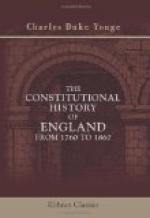The Union with Ireland was the last great work of Pitt’s first administration, and a noble close to the legislation of the eighteenth century. But the last months of the year were also signalized by another enactment, which, though it cannot be said to have anything of a character strictly entitled to the name of constitutional, nevertheless established a practice so valuable as the foundation of a great part of our domestic legislation, that it will, perhaps, hardly be considered foreign to the scope and purpose of this volume to record its commencement. In November, 1800, Mr. Abbott, the member for Helstone, brought in a bill to take a census of the people of the United Kingdom, pointing out not only the general importance of a knowledge of the population of a country in its entire amount and its different classes to every government, but also its special bearing on agriculture and on the means requisite to provide subsistence for the people, on trade and manufactures, and on our resources for war. Such a census as he proposed had been more than once taken in Holland, Sweden, Spain, and even in the United States, young as was their separate national existence; it had been taken once—nearly fifty years previous—in Scotland; and something like one had been furnished in England in the reign of Edward III. by a subsidy roll, and in that of Elizabeth by diocesan returns furnished by the Bishops to the Privy Council.[148] He farther argued for the necessity of such a proceeding from the different notions entertained by men of sanguine or desponding tempers as to the increase or diminution of the population. “Some desponding men had asserted that the population had decreased by a million and a half between the Revolution and Peace of Paris, in 1763; others (of whom the speaker himself was one) believed that, on the contrary, it had increased in that interval by two millions.” His motion was unanimously adopted by both Houses; and when the census was taken, its real result furnished as strong a proof of its usefulness as any of the mover’s arguments, by the extent of the prevailing miscalculations which it detected. For Mr. Abbott, who had spared no pains to arrive at a correct estimate, while he mentioned that some persons reckoned the population of England and Wales at 8,000,000, pronounced that, according to other statements, formed on a more extensive investigation, and, as it seemed to him, on a more correct train of reasoning, the total number could not be less than 11,000,000. In point of fact, excluding those employed in the army and navy, who were nearly half a million, the number for England and Wales fell short of nine millions.[149] It would be quite superfluous to dilate on the value of the information thus supplied, without which, indeed, much of our subsequent legislation on poor-laws, corn-laws, and all matters relating to rating and taxation, would have been impracticable or the merest guesswork.




